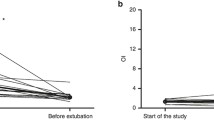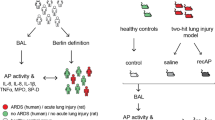Abstract
Objective
Ex vivo perfused and ventilated lung lobes frequently develop pulmonary edema. We were looking for a suitable and early detectable biomarker in the perfusion fluid indicating lung cell damage and loss of tissue integrity in ventilated human lung lobes. Therefore, we elucidated whether surfactant protein A (SP-A) and angiotensin-converting enzyme (ACE) were measurable in the perfusion fluid and whether they were suitable indicators for edema formation occurring within the experimental time frame of 1–2 h.
Methods
Patients (n = 39) undergoing a lobectomy, bilobectomy or pneumonectomy due to primary bronchial cell carcinoma were included in the studies. Lung lobes were extracorporally ventilated and perfused for up to 2 h. Two different perfusion fluids were used, plain perfusion buffer and perfusion buffer containing packed erythrocytes or buffy coats. Perfusion fluid samples were analyzed for SP-A and ACE using immunoassays served as perfusion fluids.
Results
SP-A and ACE concentrations were analyzed in fluid sample sets of 39 and 33 perfusion experiments, respectively. Degrees of edema formation were arbitrarily classified into three groups (≤29, 30–59, ≥60 % weight gain). The maximum increase of SP-A and ACE concentrations in the perfusate was significantly higher for more pronounced edemas in case of perfusions using a mixture of blood components and buffer. Interestingly, the time courses of ACE and SP-A were highly similar.
Conclusion
We suggest that SP-A and ACE are promising early biochemical markers for the development for pulmonary edema formation in the ex vivo lung lobe perfusion.



Similar content being viewed by others
References
Murray JF (2011) Pulmonary edema: pathophysiology and diagnosis. Int J Tuberc Lung Dis 15:155–160
Sartori C, Rimoldi SF, Scherrer U (2010) Lung fluid movements in hypoxia. Prog Cardiovasc Dis 52:493–499
Gattinoni L, Carlesso E, Cadringher P, Valenza F, Vagginelli F, Chiumello D (2003) Physical and biological triggers of ventilator-induced lung injury and its prevention. Eur Respir J Suppl 47:15s–25s
Piacentini E, Lopez-Aguilar J, Garcia-Martin C, Villagra A, Saenz-Valiente A, Murias G et al (2008) Effects of vascular flow and PEEP in a multiple hit model of lung injury in isolated perfused rabbit lungs. J Trauma 65:147–153
Villar J, Herrera-Abreu MT, Valladares F, Muros M, Perez-Mendez L, Flores C et al (2009) Experimental ventilator-induced lung injury: exacerbation by positive end-expiratory pressure. Anesthesiology 110:1341–1347
Hong CM, Xu DZ, Lu Q, Cheng Y, Pisarenko V, Doucet D et al (2010) Low tidal volume and high positive end-expiratory pressure mechanical ventilation results in increased inflammation and ventilator-associated lung injury in normal lungs. Anesth Analg 110:1652–1660
Briel M, Meade M, Mercat A, Brower RG, Talmor D, Walter SD et al (2010) Higher vs lower positive end-expiratory pressure in patients with acute lung injury and acute respiratory distress syndrome: systematic review and meta-analysis. JAMA 303:865–873
Linder A, Friedel G, Fritz P, Kivisto KT, McClellan M, Toomes H (1996) The ex vivo isolated, perfused human lung model: description and potential applications. Thorac Cardiovasc Surg 44:140–146
Freiwald M, Valotis A, Kirschbaum A, McClellan M, Mürdter T, Fritz P et al (2005) Monitoring the initial pulmonary absorption of two different beclomethasone dipropionate aerosols employing a human lung reperfusion model. Respir Res 6:21
Cypel M, Yeung JC, Hirayama S, Rubacha M, Fischer S, Anraku M et al (2008) Technique for prolonged normothermic ex vivo lung perfusion. J Heart Lung Transplant 27:1319–1325
Pugin J, Dunn I, Jolliet P, Tassaux D, Magnenat JL, Nicod LP et al (1998) Activation of human macrophages by mechanical ventilation in vitro. Am J Physiol 275:L1040–L1050
Ranieri VM, Suter PM, Tortorella C, De Tullio R, Dayer JM, Brienza A et al (1999) Effect of mechanical ventilation on inflammatory mediators in patients with acute respiratory distress syndrome: a randomized controlled trial. JAMA 282:54–61
Jaecklin T, Engelberts D, Otulakowski G, O’Brodovich H, Post M, Kavanagh BP (2011) Lung-derived soluble mediators are pathogenic in ventilator-induced lung injury. Am J Physiol Lung Cell Mol Physiol 300:L648–L658
Meier T, Lange A, Papenberg H, Ziemann M, Fentrop C, Uhlig U et al (2008) Pulmonary cytokine responses during mechanical ventilation of noninjured lungs with and without end-expiratory pressure. Anesth Analg 107:1265–1275
Wallace MJ, Probyn ME, Zahra VA, Crossley K, Cole TJ, Davis PG et al (2009) Early biomarkers and potential mediators of ventilation-induced lung injury in very preterm lambs. Respir Res 10:19
Fukuse T, Albes JM, Takahashi Y, Brandes H, Hausen B, Schafers HJ (1995) Influence of red blood cells on lung function in an ex vivo rat heart–lung model. J Surg Res 59:399–404
Bernard CE, Dahlby R, Hoener B (1997) An isolated perfused lung model with real time data collection and analysis of lung function. J Pharmacol Toxicol Methods 38:41–46
Nyhlen K, Rippe B, Hultkvist-Bengtsson U (1997) An isolated blood-perfused guinea-pig lung model for simultaneous registration of haemodynamic, microvascular and respiratory variables. Acta Physiol Scand 159:293–302
Schumann S, Kirschbaum A, Schliessmann SJ, Wagner G, Goebel U, Priebe HJ et al (2010) Low pulmonary artery flush perfusion pressure combined with high positive end-expiratory pressure reduces oedema formation in isolated porcine lungs. Physiol Meas 31:261–272
Nowak K, Gross W, Nicksch K, Hanusch C, Helbig M, Hohenberger P et al (2011) Intraoperative lung edema monitoring by microwave reflectometry. Interact Cardiovasc Thorac Surg 12:540–544
Weaver TE, Whitsett JA (1991) Function and regulation of expression of pulmonary surfactant-associated proteins. Biochem J 273(Pt 2):249–264
Hamm H, Fabel H, Bartsch W (1992) The surfactant system of the adult lung: physiology and clinical perspectives. Clin Investig 70:637–657
Floros J, Wang G, Mikerov AN (2009) Genetic complexity of the human innate host defence molecules, surfactant protein A1 (SP-A1) and SP-A2—impact on function. Crit Rev Eukaryot Gene Expr 19:125–137
Doyle IR, Nicholas TE, Bersten AD (1995) Serum surfactant protein-A levels in patients with acute cardiogenic pulmonary edema and adult respiratory distress syndrome. Am J Respir Crit Care Med 152:307–317
Doyle IR, Bersten AD, Nicholas TE (1997) Surfactant proteins-A and -B are elevated in plasma of patients with acute respiratory failure. Am J Respir Crit Care Med 156:1217–1229
Cheng IW, Ware LB, Greene KE, Nuckton TJ, Eisner MD, Matthay MA (2003) Prognostic value of surfactant proteins A and D in patients with acute lung injury. Crit Care Med 31:20–27
Greene KE, Wright JR, Steinberg KP, Ruzinski JT, Caldwell E, Wong WB et al (1999) Serial changes in surfactant-associated proteins in lung and serum before and after onset of ARDS. Am J Respir Crit Care Med 160:1843–1850
Eisner MD, Parsons P, Matthay MA, Ware L, Greene K (2003) Plasma surfactant protein levels and clinical outcomes in patients with acute lung injury. Thorax 58:983–988
Ryan JW, Ryan US, Schultz DR, Whitaker C, Chung A (1975) Subcellular localization of pulmonary angiotensin-converting enzyme (kininase II). Biochem J 146:497–499
Parkin ET, Turner AJ, Hooper NM (2004) Secretase-mediated cell surface shedding of the angiotensin-converting enzyme. Protein Pept Lett 11:423–432
Atochina EN, Muzykantov VR, Al-Mehdi AB, Danilov SM, Fisher AB (1997) Normoxic lung ischemia/reperfusion accelerates shedding of angiotensin converting enzyme from the pulmonary endothelium. Am J Respir Crit Care Med 156:1114–1119
Atochina EN, Balyasnikova IV, Danilov SM, Granger DN, Fisher AB, Muzykantov VR (1998) Immunotargeting of catalase to ACE or ICAM-1 protects perfused rat lungs against oxidative stress. Am J Physiol 275:L806–L817
Hollinger MA, Giri SN, Patwell S, Zuckerman JE, Gorin A, Parsons G (1980) Effect of acute lung injury on angiotensin converting enzyme in serum, lung lavage, and effusate. Am Rev Respir Dis 121:373–376
Nukiwa T, Matsuoka R, Takagi H, Ishii Y, Arai T, Kira S (1982) Responses of serum and lung angiotensin-converting enzyme activities in the early phase of pulmonary damage induced by oleic acid in dogs. Am Rev Respir Dis 126:1080–1086
Nowak K, Kamler M, Bock M, Motsch J, Hagl S, Jakob H et al (2002) Bronchial artery revascularization affects graft recovery after lung transplantation. Am J Respir Crit Care Med 165:216–220
Studdy PR, Lapworth R, Bird R (1983) Angiotensin-converting enzyme and its clinical significance: a review. J Clin Pathol 36:938–947
Votta-Velis EG, Minshall RD, Visintine DJ, Castellon M, Balyasnikova IV (2007) Propofol attenuates endotoxin-induced endothelial cell injury, angiotensin-converting enzyme shedding, and lung edema. Anesth Analg 105:1363–1370
Krieger B, Schwartz J, Loomis W, Marsh J, Spragg R (1984) Nonspecificity of elevated angiotensin-converting enzyme activity in bronchoalveolar lavage fluid from high permeability lung edema states. Am Rev Respir Dis 129:499–500
De Jongh RF, De Backer WA, Mohan R, Jorens PG, van Overveld FJ (1993) Angiotensin-converting enzyme activity in serum and bronchoalveolar lavage fluid after damage to the alveolo-capillary barrier in the human lung. Intensive Care Med 19:390–394
Jiang JS, Wang LF, Chou HC, Chen CM (2007) Angiotensin-converting enzyme inhibitor captopril attenuates ventilator-induced lung injury in rats. J Appl Physiol 102:2098–2103
Wösten-van Asperen RM, Lutter R, Haitsma JJ, Merkus MP, van Woensel JB, van der Loos CM et al (2008) ACE mediates ventilator-induced lung injury in rats via angiotensin II but not bradykinin. Eur Respir J 31:363–371
Imai Y, Kuba K, Rao S, Huan Y, Guo F, Guan B et al (2005) Angiotensin-converting enzyme 2 protects from severe acute lung failure. Nature 436:112–116
Cambien F, Alhenc-Gelas F, Herbeth B, Andre JL, Rakotovao R, Gonzales MF et al (1988) Familial resemblance of plasma angiotensin-converting enzyme level: the Nancy study. Am J Hum Genet 43:774–780
Larsson P, Mirgorodskaya E, Samuelsson L, Bake B, Almstrand AC, Bredberg A et al (2012) Surfactant protein A and albumin in particles in exhaled air. Respir Med 106:197–204
Grönhagen-Riska C (1979) Angiotensin-converting enzyme. I. Activity and correlation with serum lysozyme in sarcoidosis, other chest or lymph node diseases and healthy persons. Scand J Respir Dis 60:83–93
Kuroki Y, Takahashi H, Chiba H, Akino T (1998) Surfactant proteins A and D: disease markers. Biochim Biophys Acta 1408:334–345
Acknowledgments
We express our gratitude to PD Dr. Cordula Stamme from the Research center in Borstel, Germany, for providing us with purified SP-A standard protein. M. Gnadt was supported by a PhD grant from GlaxoSmithKline (GSK).
Conflict of interest
All authors declare that they do not have any conflict of interest with regard to the content of the present manuscript.
Author information
Authors and Affiliations
Corresponding author
Rights and permissions
About this article
Cite this article
Gnadt, M., Kardziev, B., Schmidt, M. et al. Surfactant Protein A (SP-A) and Angiotensin Converting Enzyme (ACE) as Early Biomarkers for Pulmonary Edema Formation in Ventilated Human Lung Lobes. Lung 190, 431–440 (2012). https://doi.org/10.1007/s00408-012-9386-8
Received:
Accepted:
Published:
Issue Date:
DOI: https://doi.org/10.1007/s00408-012-9386-8




